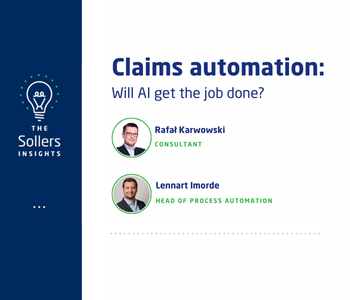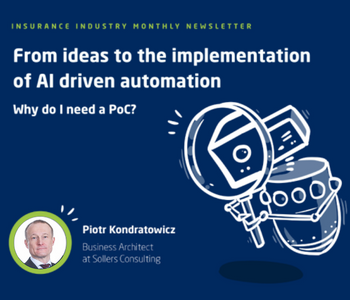The insurance industry is characterised by too many paper-based processes and a low level of process automation.
Head of Process Automation
Sollers Consulting
Accelerate your business and improve its efficiency
Accelerate your business and improve its efficiency
Challenged by competitive markets, insurers are looking for their next steps in process automation.
Serving increasingly demanding clients and distribution partners, many insurance companies are still behind in terms of the speed and quality of their digital services. They are looking for new solutions in business process automation to improve the level of their services, accelerate typical insurance processes and overcome transactional frictions which are still common in the industry. Business process automation enhances all the functions of the insurance industry. It is applied in policy administration, claims handling and many other areas of the insurance value chain.
Sollers helps insurers to:


The insurance industry is characterised by too many paper-based processes and a low level of process automation.

Lennart Imorde
Head of Process Automation
Sollers Consulting
Based on the experience from more than 150 insurance core system implementation projects,
...Sollers experts have designed thousands of business processes helping insurers to increase their degree of automation. Supporting a variety of insurance companies worldwide, Sollers consultants rely on their experience in Business Process Management Notation (BPMN), Case Management Model and Notation (CMMN) and Decision Management Notation (DMN). Their expertise and hands-on approach have helped insurers to cut their costs and to boost the quality of their service.










Identifying the right processes to automate, ensuring data quality, creativity to imagine an automated process and not rebuild existing processes in an automated fashion and the change management for employees.
Benefits include increased efficiency, reduced costs, improved accuracy, faster turnaround times, and better regulatory compliance.
The metrics that define the success of automation are very much dependent on the company strategy. In any case relevant are metrics like processing times, error rates, customer satisfaction, and increased efficiency. Additionally, there are process specific KPI’s such as the average claim handling time or claims processed per employee.
Many automation tools offer integration capabilities through APIs (Application Programming Interfaces) or connectors. This allows them to interact and exchange data with existing insurance systems. Others might use RPA (Robotic Process Automation) to automate legacy systems. Before considering the tools and how they are integrated it is, however, crucial to define what the target process should achieve.
Automated systems can introduce new vulnerabilities. Ensure strong access control, data encryption, and regular security audits to mitigate these risks. Additionally, consider introducing automated processes gradually to avoid a big bang automation that might overwhelm existing users.
Automation can analyze large amounts of data to identify patterns and anomalies that might indicate fraudulent activity. It can also streamline risk assessment processes.
Repetitive, rule-based tasks are ideal candidates. This includes data entry, policy issuance, claims processing, and renewal notifications. There are processes with potential for automation in all areas of the insurance value chain.
Automation can speed up processes, improve accuracy, and offer customers 24/7 self-service options. This can lead to a more positive customer experience. In a recent studie conducted by Sollers Consulting Claim processing times were found to be the most crucial to customer satisfaction.
Automation can ensure tasks are completed consistently and according to the framework of rules that is defined. It can also automate reporting and data collection for compliance audits. Thereby automation can contribute to transparency of insurance processes.